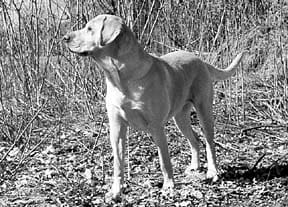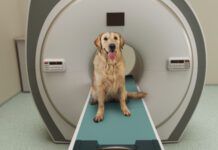Hannah was a normal, healthy Labrador Retriever puppy: happy, boisterous, playful, and always willing to eat. Hannah’s owner, Connecticut resident Anne Hassett, bought Hannah when the pup was seven weeks old. Hassett trained, socialized, and loved the golden pup. A field-line Labrador, Hannah hunted on the weekends and enjoyed the comfy life of a companion Lab weekdays. Hannah was well known in hunting circles for her steady, easy-going temperament, the coveted hallmark of the Labrador breed. Hassett considered breeding her, and had the dog examined and tested for genetic diseases.
But when Hannah was about 18 months old, she acted aggressively toward another dog in an agility class. Hassett attributed this uncharacteristic behavior to the fact that Hannah was in heat. Hannah acted odd in her in obedience class, too. When asked to be at attention in the heel position, Hassett says the dog got a strange expression on her face. “I thought she didn’t like the atmosphere in class,” says Hassett.
But then Hannah’s behavior began deteriorating in more and more situations. She went from exhibiting aggression toward a certain type of dog (dark-faced dogs especially) to any dog, including a Golden Retriever puppy. “This just kept escalating on its own, and I couldn’t really figure out what had happened to my dog. She nailed this pup and did some serious puncturing. This was the first time she ever tried to bite and she nailed this dog in about a second before I could pull her off,” says Hassett.

Hassett consulted with knowledgeable Labrador enthusiasts who recommended not breeding the dog because even though Hannah was physically sound, her temperament wasn’t.
Hassett was upset and frustrated by Hannah’s change in disposition. She tried to reason why the dog had showed signs of aggression. Hassett knew she had trained and socialized the Lab since puppyhood, and had worked with good trainers using only positive, gentle methods. “I wondered, ‘What happened to my wonderful dog’?” says Hassett.
On the advice of her sister-in-law, who is a dog trainer, Hassett tried some new techniques to modify Hannah’s behavior. It helped some, says Hassett, but only to a point. Hannah was able to control herself only as long as other dogs kept a distance.
Soon Hassett noticed that her normally boisterous Lab was sluggish, lethargic. Hannah would sleep all night, get up to eat, then try to go back to sleep all morning. She seemed depressed, and even stopped wagging her tail (very unusual for a Lab!). She was reluctant to greet visitors, and would only get up to greet people she really liked.
Initial veterinary exam
Next, Hassett consulted with her veterinarian. However, a comprehensive exam and several laboratory tests failed to reveal a physical cause for Hannah’s change in behavior. The vet believed it was a behavioral issue and recommended continued training. Hassett did continue the training, but Hannah’s aggression persisted.
When Hannah was 3 1/2 years old, Hassett bought and read The Holistic Guide for a Healthy Dog, by Wendy Volhard and Kerry L. Brown, DVM. Many of the trainers she worked with utilized a natural approach, so Hassett thought she’d give it a try. Perhaps a natural diet, supplements, herbal remedies or Bach flowers, would help Hannah, thought Hassett. She read the book, paying special attention to the parts that interested her, and tried different approaches. Unfortunately, she said, she had no great success with anything she tried.
Hassett consulted with her veterinarian again. The vet agreed that Hannah wasn’t the same dog, but results from a new round of tests were normal. “She had nothing to say to me other than to say she did believe something was wrong,” says Hassett.
That Christmas Hannah’s aggressive behavior turned in a new direction. When Hassett hosted a holiday party that included adults and children, Hannah growled at several children who attended the festivities. Of course, Hassett was devastated by this, frustrated and upset she was unable to solve Hannah’s behavioral problems. She knew deep down that something was wrong with her beautiful dog.
Better on a re-read
Interestingly, Hassett picked up the Holistic Guide for a Healthy Dog again, and this time, found herself drawn to the chapter on chiropractic care, which she had skipped the first time around. “For some reason, I never bothered with the chiropractic chapter,” says Hassett. But when she did read it, she couldn’t believe her eyes. There in black and white was a checklist of 12 reasons to consider chiropractic care for your dog. Hassett read through the list, noting that Hannah had five of the 12 symptoms, including a tail that doesn’t wag symmetrically, an anxious look on the face, sensitive skin, a lumpy, bumpy feel to the spine, and a tail that is held straight or not relaxed.
Encouraged, Hassett took the book to her vet and asked her opinion. The vet agreed Hassett could give chiropractic a try, and recommended a holistic practitioner nearby.
In January 1999, Hassett contacted Bud Allen, MS, DVM, at the Family Veterinary Center in Haydenville, Massachusetts. Dr. Allen, who is board certified in chiropractic and acupuncture, examined Hannah and adjusted her spine, primarily in the head and neck. He also treated her with acupuncture. Dr. Allen didn’t make any promises about Hannah’s behavior, but did say that the adjustments he made on the dog were similar to adjustments made in people to relieve migraine headaches. Hassett says she was a little disappointed the veterinarian didn’t have more to say, but was willing to wait and see if the adjustments helped.
On the way home in the car, Hannah did something she hadn’t done for quite a while. She crawled into the front seat, sat next to Hassett and put her golden head in Hassett’s lap. “I almost cried,” says Hassett. “This dog was telling me that whatever happened there was something she needed.” When the pair arrived at home, Hannah greeted Hassett’s husband with a wagging tail. “I was a believer in a couple of hours,” she says.
Emotional roller coaster
Hassett called Dr. Allen’s office the next day to report the seemingly positive results. The practitioner suggested treatment every eight weeks for a combination therapy of chiropractic and acupuncture.
Hannah improved over the next few months. She was happy again, more energetic, less grumpy. Hassett was thrilled. But in the fall of 1999, Hannah started getting irritable again. By this time, Hassett was convinced that Hannah’s aggressive behavior was because of pain.
Hassett returned to her allopathic vet for another complete exam: bloodwork, x-rays, thyroid tests, ultrasound. The radiographs of the dog’s spine revealed spondylitis, an arthritic condition in which the there is a buildup of calcium on the spine. Spondylitis is uncommon in Labradors. It involves inflammation of the vertebrae, which the body attempts to limit by stabilizing spinal movements with calcium deposits. In time, the calcium deposits encroach on the nerves in the spine, impaired function and causing great pain. The vet told Hassett that Hannah had the spine of a 10-year-old dog, and the condition could cause enough pain to make Hannah behave aggressively.
The veterinarian recommended against starting Hannah on anti-inflammatory medication because of the dog’s young age, since long-term use can cause gastric ulceration. But she did want to put the dog on steroids for a short period to eliminate pain and see if there was any change in Hannah’s behavior. There was, and Hassett now knew Hannah’s grumpy, aggressive moods were rooted in the pain she experienced.
What to do about the pain was the next challenge. Dr. Allen reviewed Hannah’s x-rays, and recommended treatment every three weeks. Hassett also began feeding Hannah a raw diet based on the book, Give Your Dog a Bone, by Ian Billinghurst, DVM, and added a chondroitin sulfate supplement.
Since January 2000, Hannah has really improved. “Hannah’s in a great mood,” says Hassett. “She hasn’t had a bad morning for quite a while. She receives treatment from Dr. Allen every six weeks, or more often if needed.” Hassett is thankful, and even feels lucky, that she considered alternative treatment for Hannah. “For me, the bottom line was if I hadn’t looked into alternative methods, if I had been the pet owner I was 10 years ago, I could imagine having her put down by now. We are so lucky.”
-By Virginia Parker Guidry
Virginia Parker Guidry is a freelance writer from San Diego, CA.
Holistic Case Histories
Does your dog have a good holistic health or training story to share with WDJ? Have gentle training methods or complementary medicine improved the well-being of your dog? If so, send some information about your dog to: WDJ Case Histories, 1175 Regent Street, Alameda, CA 94501. If we select your dog’s story, we will have a writer contact you for more details.





